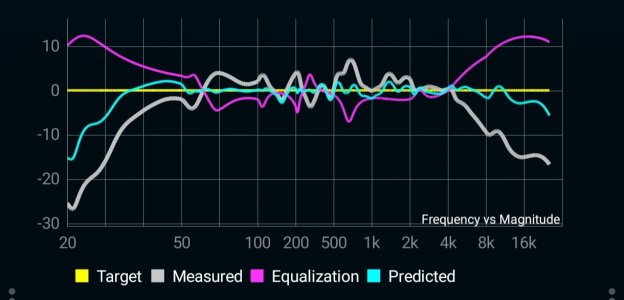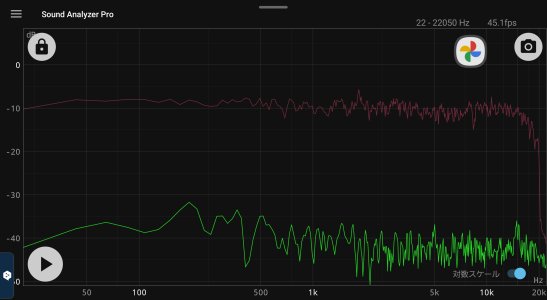You are using an out of date browser. It may not display this or other websites correctly.
You should upgrade or use an alternative browser.
You should upgrade or use an alternative browser.
Enhanced Room Correction is Here!
- Thread starter RyanWithWiiM
- Start date
-
- Tags
- room correction
slartibartfast
Major Contributor
- Joined
- Apr 18, 2024
- Messages
- 5,512
If you are going to correct high frequencies you are definitely going to need to be able to import calibration files for external microphones. They tend to be pretty flat up to 4kHz but higher than that and all bets are off.The primary difference lies in performance between the 20-50Hz bass range and frequencies above 16kHz. The updated Room Correction provides better measurement of the room's transfer function, leading to more accurate calibration. This is especially beneficial if you're using subwoofers or speakers with strong bass in those rooms. Additionally, the new Room Correction improves treble adjustment, making it more effective for those looking to fine-tune higher frequencies.
And for those who love spoilers:
We're also working on a couple more things for Room Correction for the future:
1. Integrating independent PEQ Room Correction with subwoofer, enabling automatic level matching between the main speakers and the subwoofer.
2. Enhancing Room Correction by using multiple measurements at one spot to eliminate environmental noise.
I agree with you, but the low and high frequencies have large curves with small Q values. It seems that no detailed correction is made here, so the effect of the lack of calibration may be less than expected.If you are going to correct high frequencies you are definitely going to need to be able to import calibration files for external microphones. They tend to be pretty flat up to 4kHz but higher than that and all bets are off.
slartibartfast
Major Contributor
- Joined
- Apr 18, 2024
- Messages
- 5,512
Here are two calibration files for the iMM6. The difference at higher frequencies is at least 4dBI agree with you, but the low and high frequencies have large curves with small Q values. It seems that no detailed correction is made here, so the effect of the lack of calibration may be less than expected.
Post in thread 'Microphone calibration files' https://forum.wiimhome.com/threads/microphone-calibration-files.4734/post-77912
ArthurStereo
Active member
- Joined
- Jun 21, 2024
- Messages
- 133
Great! But to do RC, you first need a good microphone. Are we still talking about microphones in phones? In Androids, each one is different. In iPhones, they may be better, but they are often dirty, with dust inside. Is this measurement equipment? We have been asking for the possibility of using calibrated microphones for a long time. It would be easier to help develop algorithms. Maybe that's where we should start? What's the problem here? I think I don't understand something.
Yes, but if the following corrections were made, I would only need to manually adjust one or two band. (In any case, the detailed correction is not performed.)Here are two calibration files for the iMM6. The difference at higher frequencies is at least 4dB
Post in thread 'Microphone calibration files' https://forum.wiimhome.com/threads/microphone-calibration-files.4734/post-77912

slartibartfast
Major Contributor
- Joined
- Apr 18, 2024
- Messages
- 5,512
You shouldn't need to manually adjust anything. Particularly not to compensate for errors introduced by lack of mic calibration. Nevermind the detailed correction your screenshot is showing a boost starting at 4kHz rising to +10dB at 16kHz.Yes, but if the following corrections were made, I would only need to manually adjust one or two band. (In any case, the detailed correction is not performed.)
View attachment 13185
ArthurStereo
Active member
- Joined
- Jun 21, 2024
- Messages
- 133
I also have to make corrections manually. I use IMM-6C. But why do I have to correct something manually, when I can add a calibration file? What is the point of correcting frequencies up to 20 kHz with a phone? I read that many people have very good measurement microphones. Why should they be excluded? They could help a lot in developing RC.
Your speaker started to roll off at 4K and the reason why there’s a big swing adjustment on eq at that range.Yes, but if the following corrections were made, I would only need to manually adjust one or two band. (In any case, the detailed correction is not performed.)
View attachment 13185
slartibartfast
Major Contributor
- Joined
- Apr 18, 2024
- Messages
- 5,512
The mic also rolls off there so you have a perfect stormYour speaker started to roll off at 4K and the reason why there’s a big swing adjustment on eq at that range.
It is not a manual correction for calibration errors. My correction results are clearly excessive in the high range, so if I am using RC in the 20-20k range I will need to make manual adjustments. (However, in practice I do RC in the 100-1k range, so that is not a problem.)You shouldn't need to manually adjust anything. Particularly not to compensate for errors introduced by lack of mic calibration. Nevermind the detailed correction your screenshot is showing a boost starting at 4kHz rising to +10dB at 16kHz.
The only way I could avoided that big roll off is by raising the iPhone higher and after that it was flat with minor adjustment on highest frequency.The mic also rolls off there so you have a perfect storm. Mine does anyway others may not. The point is you don't know unless you study the calibration file.
slartibartfast
Major Contributor
- Joined
- Apr 18, 2024
- Messages
- 5,512
They are with a calibrated mic
slartibartfast
Major Contributor
- Joined
- Apr 18, 2024
- Messages
- 5,512
I have no idea how they deal with iPhone mic calibration.The only way I could avoided that big roll off is by raising the iPhone higher and after that it was flat with minor adjustment on highest frequency.
Here’s another thing I have noticed prior to this app update. On the old algorithm, I had to adjust volume limit to avoid from clipping particularly at the treble range. There was occasional crackle that I could hear. Now with max setting there was zero crackle. It may not show on app setting but look like something was done there under the hood. Your mile may vary.
steadyshot
Major Contributor
- Joined
- Mar 14, 2023
- Messages
- 895
Please also include a cut only algorithm and an auto pregain volume after correction. I like that you mention that you will use multiple measurements in future revisions during auto eq to ensure a more accurate measurement. If all this is packed in the process together with automated independent speaker eq which benefits asymmetrical spaces , I believe the results will be much better. All this of course with an algorithm that does not cause any audible artifacts due to phase errors, but I understand that in the crucial bass region these will be less audible.
Not me!How many here can hear above that?
First of all - BRAVOWe're thrilled to announce that our Room Correction feature is getting a significant upgrade! Starting today, WiiM devices will receive big improvements to Room Correction performance when tuned, taking your listening experience to the next level.
What's New?
Broader Frequency Range: Expand the default 40Hz~4KHz frequency range to an impressive 30Hz~20kHz, enhancing both bass and high frequencies.
How to Experience the Upgrade:
To take advantage of these exciting improvements, simply update to the latest version of the WiiM Home App on your iOS or Android device, and make sure your WiiM device is running the latest firmware. Most of these changes happened server side, but we recommend making sure you have no updates pending.
Tips for Optimizing Room Correction:
A good way to evaluate the new Room Correction is by starting with bass frequency adjustments - which is much simpler than adjusting both bass and treble simultaneously. If your previous range was 40~4k Hz, try adjusting it to 20~4k Hz to see if it improves bass performance. Treble adjustments are more speaker-dependent and less influenced by the room, plus users have varying preferences for treble. The update improves treble alignment with your target curve, offering more precise control in the high-frequency range.
Questions or Feedback?
Feel free to share your thoughts or ask questions in this thread. We're always here to listen and help.
Thanks for being part of the WiiM community!
I will be able to try next week…
That is an exciting new feature.
I have my main speakers connected to the Ultra and two subwoofers to the Pro. I then play these two WiiMs as a group.
However, the Pro does not have a sub out, so I use PEQ to adjust the low pass of the sub. (My subwoofer's built-in low-pass is of little use.)
If possible, it would be great if you could add low-pass and high-pass filters to the PEQ on the WiiM devices that do not have a sub-out.
Thank you in advance for your consideration.
Hey Wiimer,
This is exactly an approach I am considering using. How are you setting and fixing the relative levels between the mains (Ultra) and the sub (Pro)? Adjusting pre-gain by ear? I assume you are happy with the results?
Similar threads
- Replies
- 11
- Views
- 647
- Replies
- 5
- Views
- 2K
- Replies
- 9
- Views
- 251
- Question
- Replies
- 13
- Views
- 2K
- Replies
- 56
- Views
- 4K

